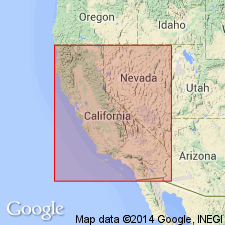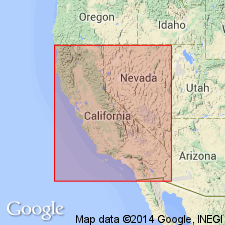
- Usage in publication:
-
- Anchor Bay Member
- Modifications:
-
- Original reference
- Dominant lithology:
-
- Arkose
- AAPG geologic province:
-
- Northern Coast Range province
Summary:
Pg. 237-238. Anchor Bay Member of Gualala Formation. Two synchronous members distinguished in Gualala Formation (rank herein reduced from group to formation) are (ascending): Stewarts Point and Anchor Bay Members. Anchor Bay Member is characterized by greenish-gray arkose, lacking potassium feldspar. Total absence of Franciscan debris in the Anchor Bay Member suggests more than 350 miles of right slip on San Andreas fault since Late Cretaceous. Age is Late Cretaceous.
Type locality not designated. Notable exposures in Gualala area, northern Coast Ranges, northwestern CA.
Source: US geologic names lexicon (USGS Bull. 1350, p. 25); GNU records (USGS DDS-6; Menlo GNULEX).

- Usage in publication:
-
- strata of Anchor Bay
- Modifications:
-
- Biostratigraphic dating
- AAPG geologic province:
-
- Northern Coast Range province
Summary:
strata of Anchor Bay. [Name Anchor Bay "Member" not used.] Gualala Group of Weaver (1943) divided into three mappable units (ascending), informally called: strata of Stewarts Point, strata of Anchor Bay, and strata of German Rancho. Strata of Anchor Bay consist of greenish-gray plagioclase arkose interbedded with gray-black mudstone and locally with conglomerate. Thickness 2,500 to 3,300 feet in Black Point anticline and about 5,500 feet in Anchor Bay anticline. Interfingers with and overlies strata of Stewart Point. Fossils include DIDYMOCERAS cf. D. HORNSBYENSE (Whiteaves), DIPLOMOCERAS sp., INOCERAMOS SUBUNDATUS Meek, and CORALLIOCHAMA ORCUTTI White indicating a Late Cretaceous age, near Campanian-Maestrichtian boundary.
Source: Modified from GNU records (USGS DDS-6; Menlo GNULEX).
- Usage in publication:
-
- Anchor Bay Member*
- Modifications:
-
- Areal extent
- Biostratigraphic dating
- AAPG geologic province:
-
- Northern Coast Range province
Wentworth, C.K., Jones, D.L., and Brabb, E.E., 1998, Geology and regional correlation of the Cretaceous and Paleogene rocks of the Gualala block, California: Society of Economic Paleontologists and Mineralogists, Pacific Section, Field Trip Guidebook, October 2, 1998, book 84, p. 3-26.
Summary:
Pg. 5 (fig. 1), 6, 7 (fig. 2), 8-9, App. 1, 2; Elder and others, this vol., p. 149-159; and McDougall, this vol., p. 169-188.
Anchor Bay Member of Gualala Formation (usage of Wentworth, PhD dissert., Stanford Univ., 1966). Characterized by distinctive greenish-gray (fresh) sandstones of plagioclase arkose and an unusual mafic suite of conglomerate clasts. Recognized along the San Andreas fault, north of San Francisco, in the Gualala block. Thickness about 800 to 1,000 m in Black Point anticline [Black Point area, Sonoma County, northwestern California], and about 1,700 m in Anchor Bay anticline [Anchor Bay area, Mendocino County, northwestern California]. Conformably overlies and interfingers with Stewarts Point Member of Gualala Formation; conformably and disconformably underlies German Rancho Formation. Fossils. Lower part of member carries Late Cretaceous (Campanian to Maastrichtian) mollusks DIDYMOCERAS sp. cf. D. HORNBYENSE, PERRISITYS COLOCARA, MURPPHITYS MADONNA, BERNAYA (PROTOCYPRAEA) GUALALAENSIS, INOCERAMUS SUBUNDATUS, and CORALLIOCHAMA ORCUTTI, planktic foraminifers GLOBOTRUNCANA (citing W.M. Sliter, USGS, personal commun., 1997), and benthic foraminifers correlative with Goudkoff's E zone (AAPG Bull., v. 29, no. 7, p. 960, table 1, 1945), citing E.H. Stinemeyer (1961-1962). Upper part of member carries interleaved Late Cretaceous and late Paleocene(?) fossils. [Age is considered Late Cretaceous and possibly late Paleocene(?). Major hiatus in early Paleocene.]
Source: Publication.
For more information, please contact Nancy Stamm, Geologic Names Committee Secretary.
Asterisk (*) indicates published by U.S. Geological Survey authors.
"No current usage" (†) implies that a name has been abandoned or has fallen into disuse. Former usage and, if known, replacement name given in parentheses ( ).
Slash (/) indicates name conflicts with nomenclatural guidelines (CSN, 1933; ACSN, 1961, 1970; NACSN, 1983, 2005, 2021). May be explained within brackets ([ ]).

